Polar night, water tower and smart safe: 5 student projects in the field of IoT
What would a student IoT training project look like? What can a student really teach for a year, if he has never come across this topic before?
The first year of the “IoT Academy Samsung” program ended with a final of the competition held between graduates from pilot universities (MIPT and MIREA). Each of the projects that reached the final was interesting in its own way, and below I suggest to get acquainted with them. This is essentially a demonstration of the range of possible topics that can be covered, based on the knowledge gained in our program.
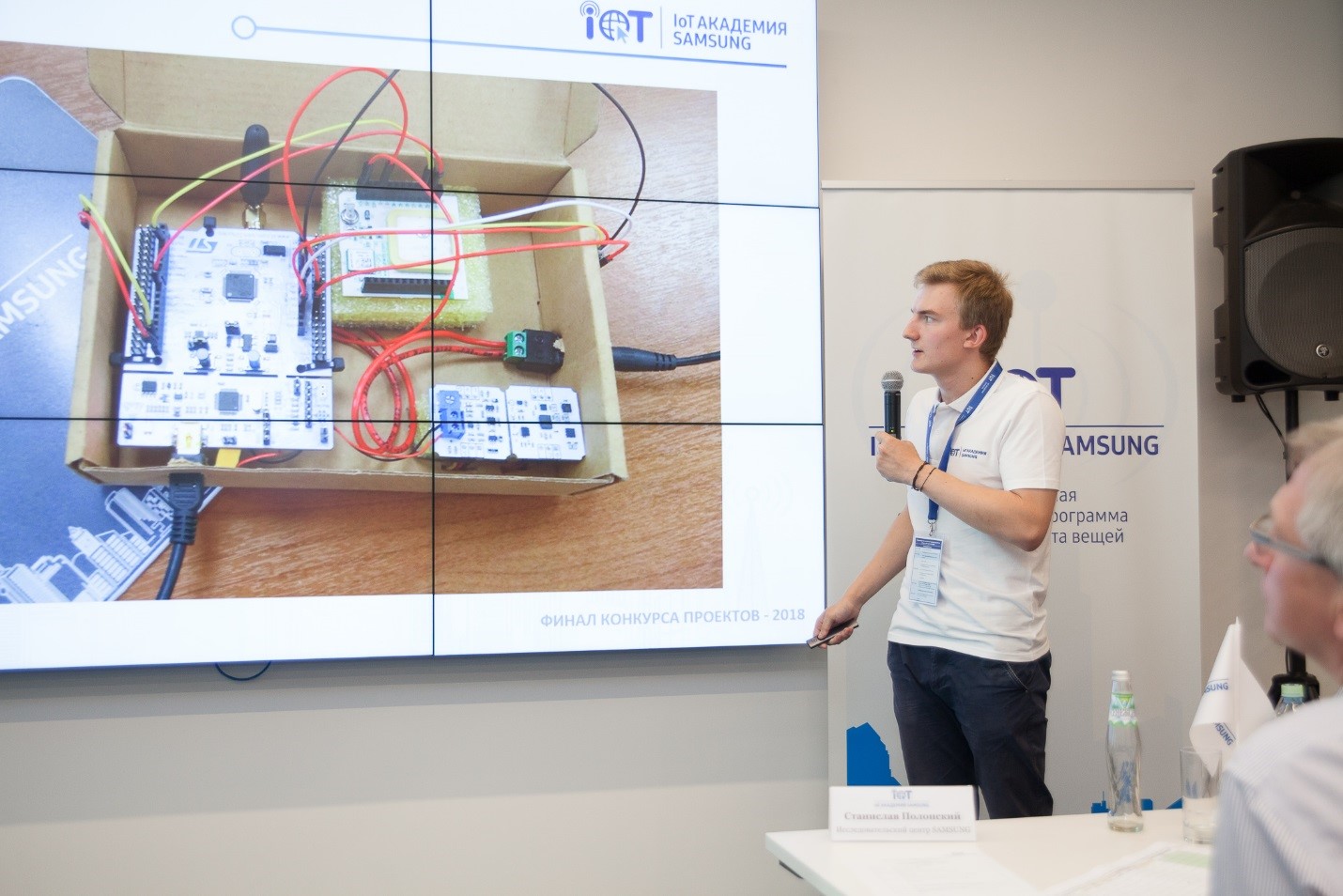
On July 12, for the first time, an event took place that ended the school year of the IoT Samsung Academy - the final of the inter-university project competition. After the first half of the year devoted to the study of case studies, students of the course at MIREA and MIPT for the entire second semester made their prototypes of the “Internet of things” devices. The students defined the ideas of the projects at their discretion, the teachers were the consultants.
')
For the final, we selected the top 10 projects. The participants had only 5 minutes to speak. A full video of what happened can be viewed on YouTube:
The projects were evaluated by a jury consisting of both professional engineers and representatives of the academic community and business. The jury chairman is Stanislav Polonsky, head of advanced research and development at the Samsung Research Center, a physicist by training, Ph.D., engineer and scientist: he worked in the US for more than 20 years, and his research interests are incredibly broad - from quantum chemistry to medical cybernetics. Your humble servant was the secretary of the jury.
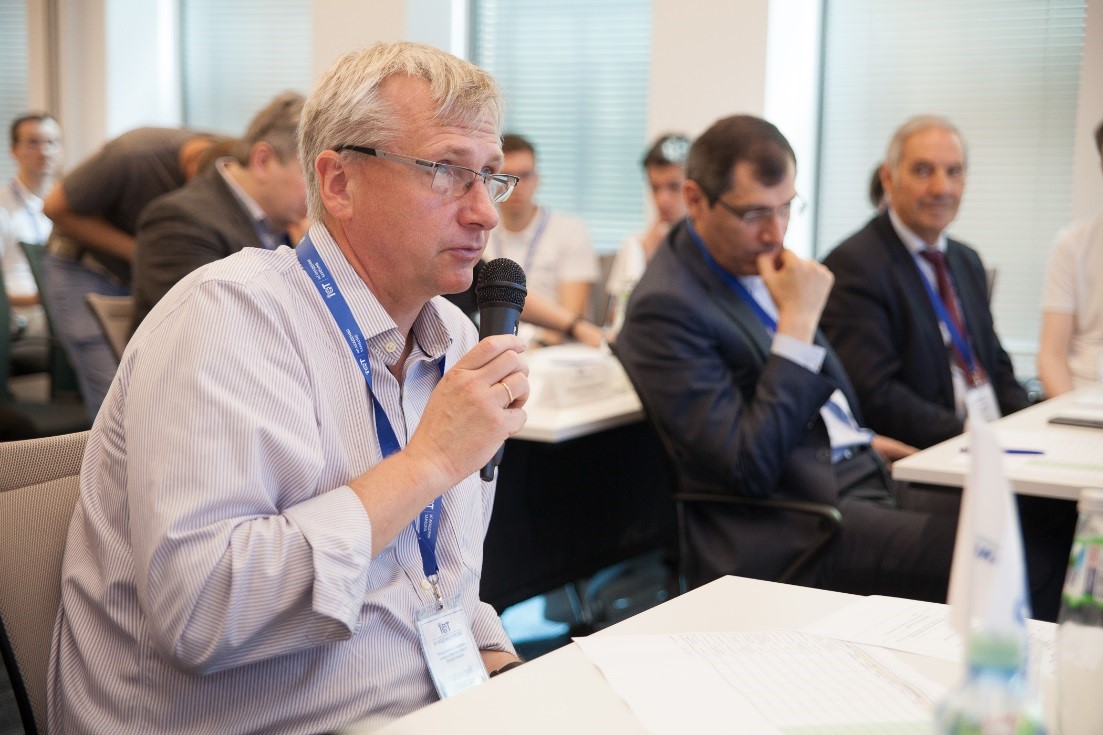
Contest nominations were as follows:
The winners received such pucks and prizes from our company.

The university-winner of the year, which is determined by the nomination "Absolute winner", was awarded the cup. In addition, the victory was on the side of MIREA in the nominations "Business and Society" and "User Choice." A student from MIPT won the nomination "Technical Excellence".
This project by unanimous decision of the jury received the prize "Absolute Winner". The author of the project, Dmitry Faychuk, completed his third year at the Institute of IT MIREA.

In our country, the rights of the junior categories “A1” and “M” are allowed to be issued, starting from 16 years. And many teenagers dream of their moped or scooter. For parents, this is a source of experiences, especially for the safety of the child. Dmitry decided to help in resolving such situations. The task of his device is to track the location and provide the parent with information about dangerous events, such as sudden braking, impact, falling, going beyond the allowed zone. The prototype is a cardboard box, inside which: an STM32 Nucleo L152RE board (this is a card in an Arduino-compatible form factor, but based on an STM32 L1 microcontroller), accelerometer modules, a GPS tracker, a vibration sensor, and a GSM connection.
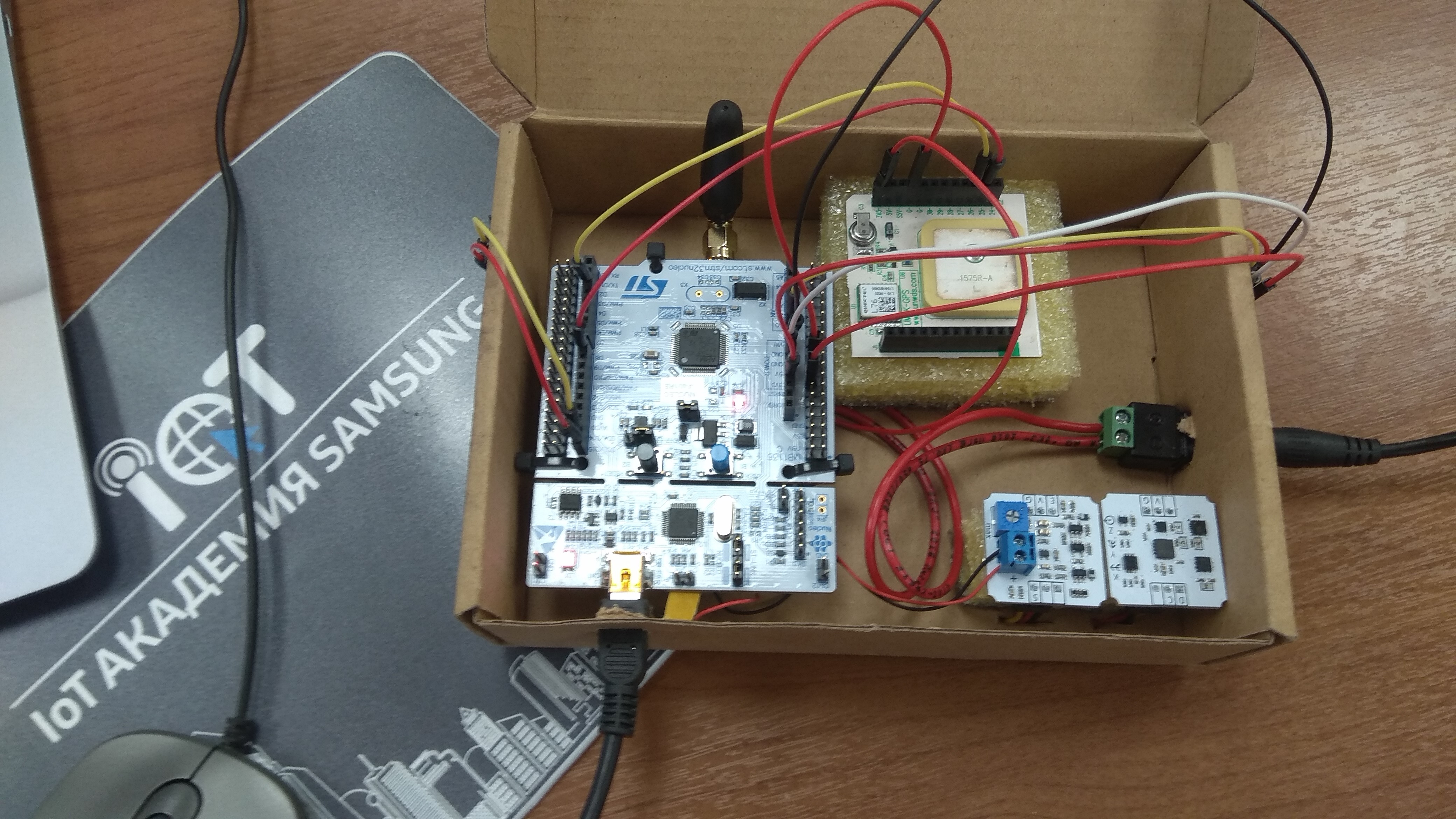
It is worth noting that the project of Dmitry is quite complex in its architecture: here both the cloud, and the mobile application, and the self-written program for the microcontroller for the RIOT OS operating system.

At the competition, the jury had an obvious question: “Why not use a modern smartphone for solving the problem, because all the necessary sensors (accelerometer, gyroscope, mobile communication) already exist in it?”. However, the author rightly noted that a separate device has several advantages: it can be mounted on a helmet or vehicle, make it non-removable, optimize battery power, make it all-weather, and so on.
The project was recognized as the best in the nomination "Technical Excellence". The judges were impressed with the degree of technical implementation of the prototype. Particularly struck by the fact that Vladislav was the youngest participant in the final round of the competition.
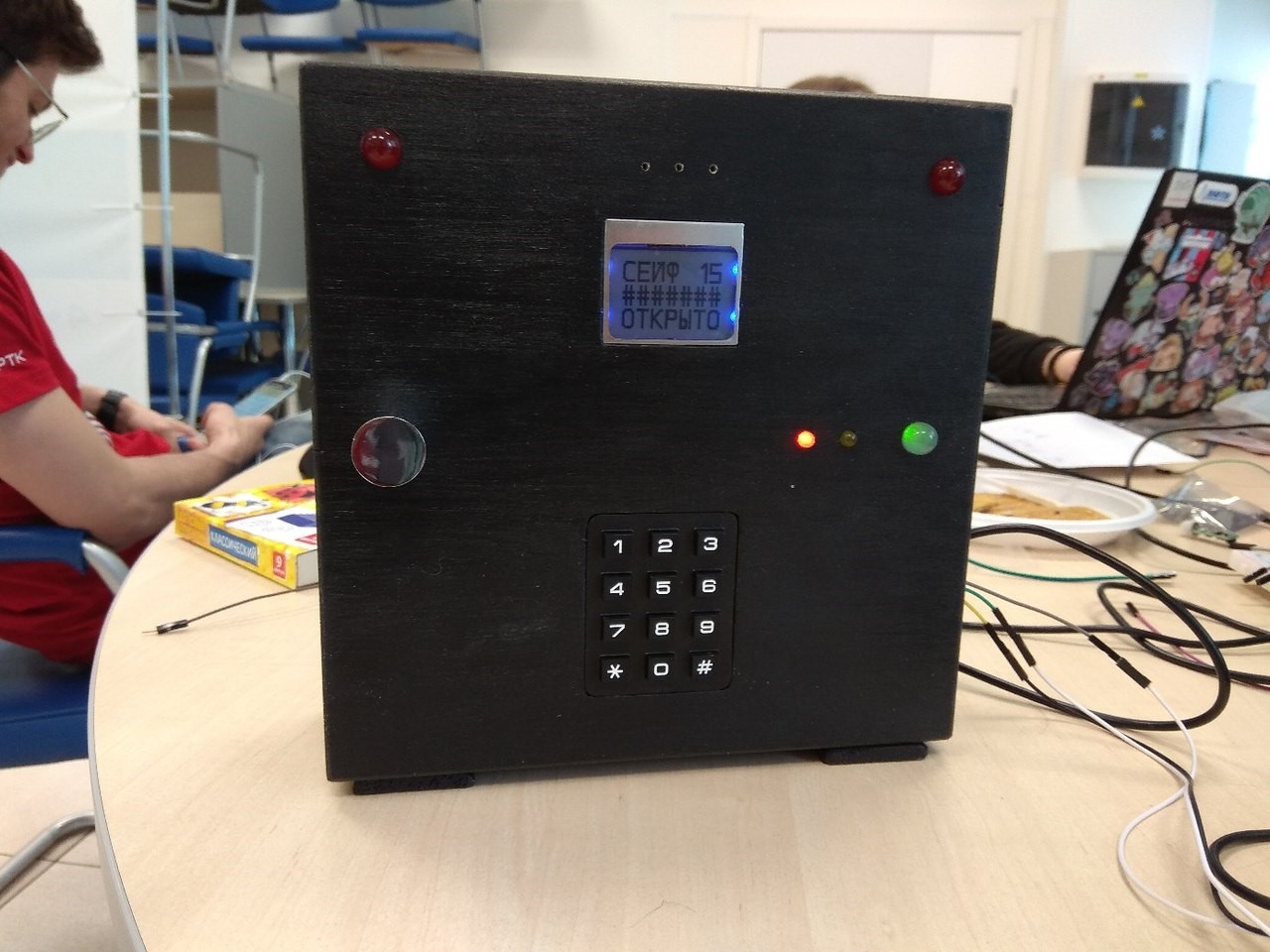
Yes, Vladislav Molodtsov is a first-year student, but many undergraduates lack such persistence and hard work. He made the most beautiful demonstration prototype. His safe looks completely real, if you don’t know that it is wooden.
We have known before that students of the Physics and Technology Institute are distinguished by a solid approach and are not looking for easy ways! One simple fact: he even assembled his own electromechanical latch on the servomotor for the door, simply because otherwise "it would not be so interesting."
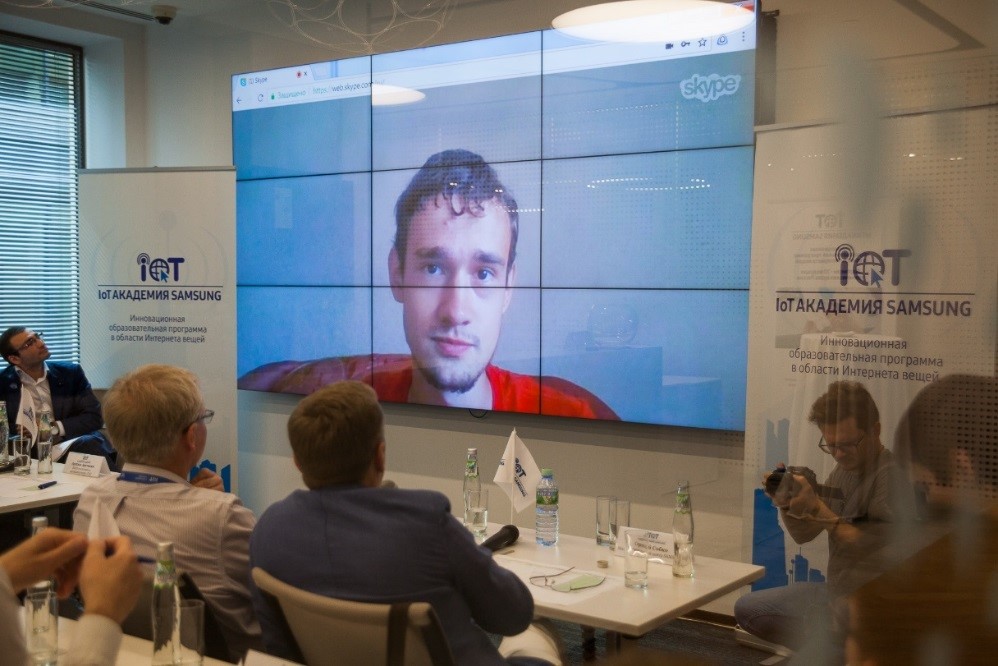
Vladislav was not able to attend in person, so the speech was held by video link.
The safe has an LCD display, a matrix keyboard, an LED display that shows the state of the safe (open / closed), for which the reed switch and magnet were used. There is a speaker to raise the alarm in case of hacking. I connected all the peripherals myself, without using third-party libraries.
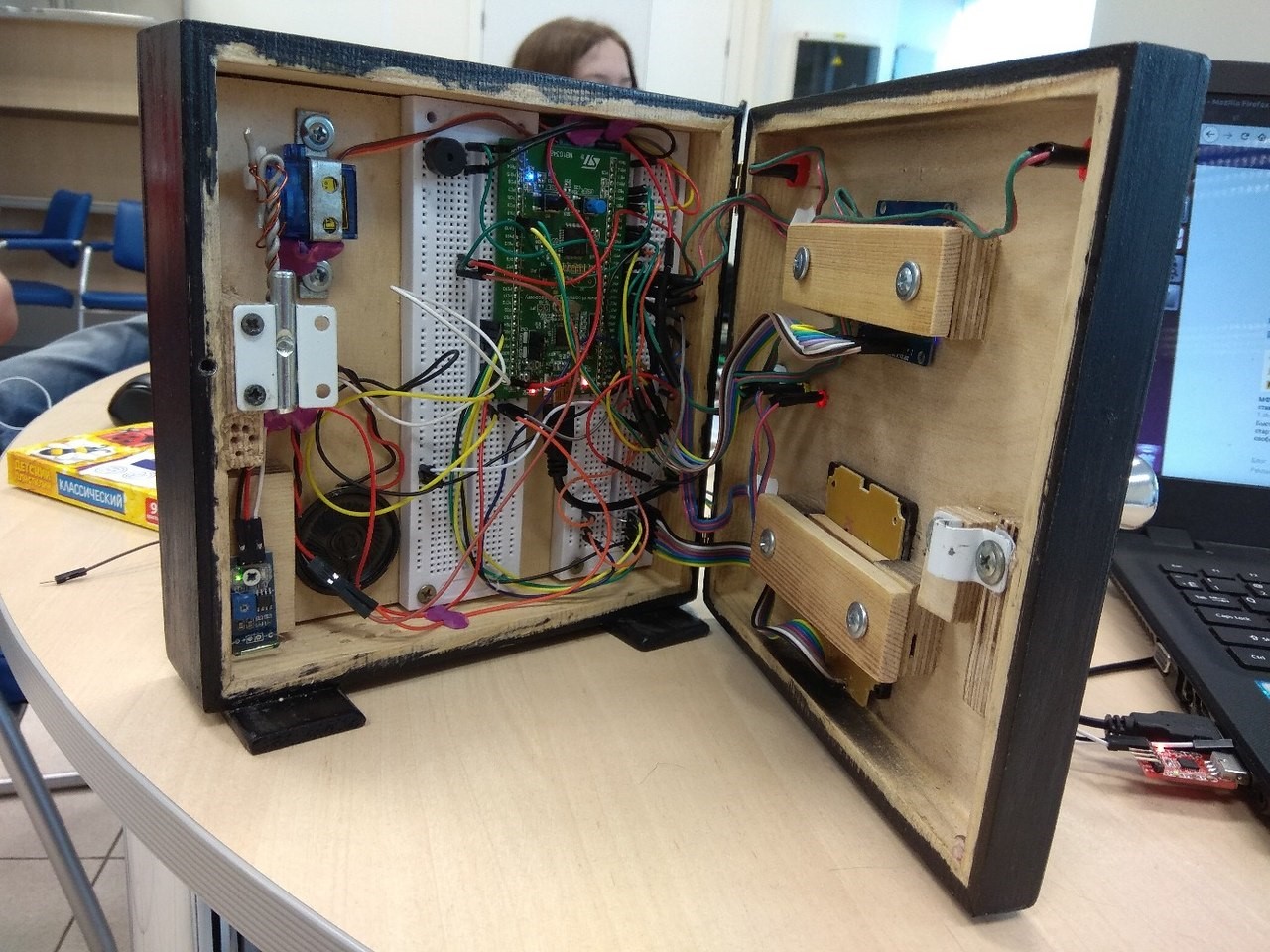
The graphical interface to the program is ingenuous, but understandable. It shows the status of each safe: open, closed, locked, hacked.
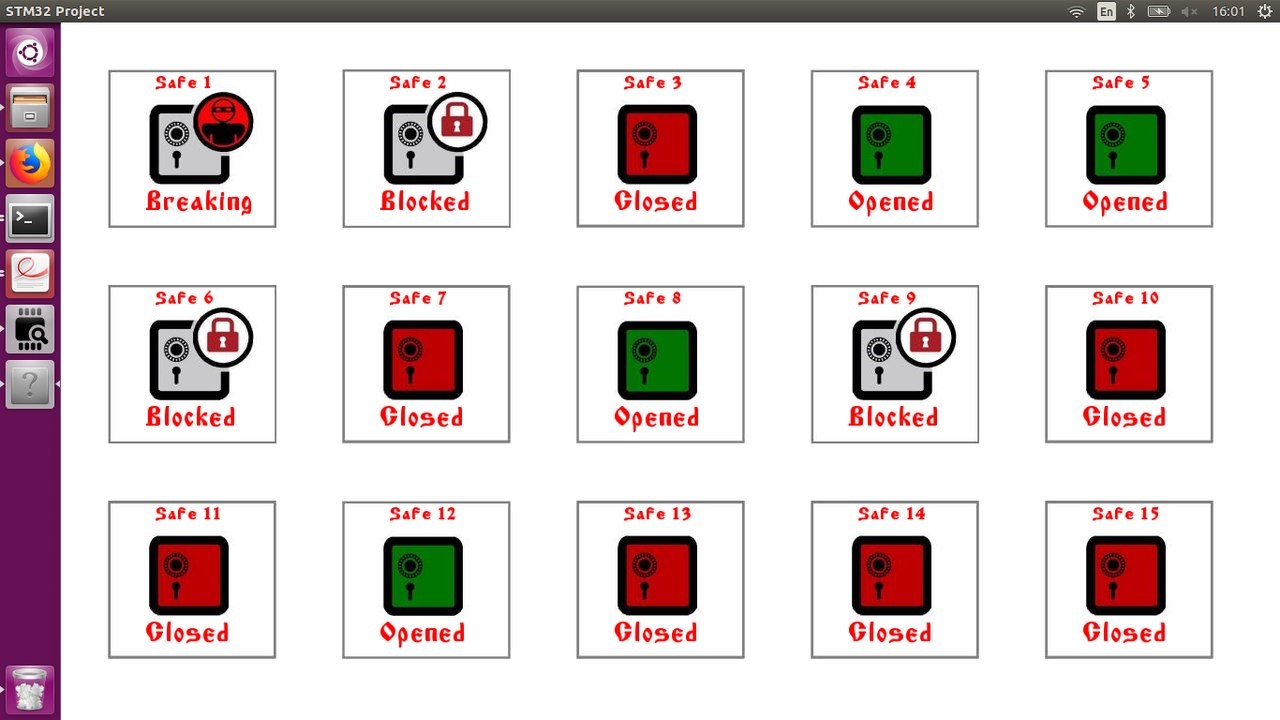
It is assumed that such a system could be claimed by hotels, sports clubs, and just any companies where employees have personal lockers. The system has not fully worked out security issues, which, obviously, should be the subject of further development of the project.
This project received a prize in the nomination "Business and Society." This nomination is undoubtedly difficult for students and teachers who do not have the necessary experience in business, and even more so in the emerging market of the Internet of Things. The discussion of the jury was stormy, but in the end the opinions of the jury members agreed that the project of Polina has real business potential.
Perhaps you heard this advice: do not use the smartphone before going to bed? The wording is not entirely correct, because we are talking about the dangers of the cold "blue" light of the smartphone screen. It is known that such light reduces the synthesis of melatonin in the human body, which is also called the sleep hormone. That is why, for example, Samsung smartphones have the option of turning on a blue light filter on a schedule.
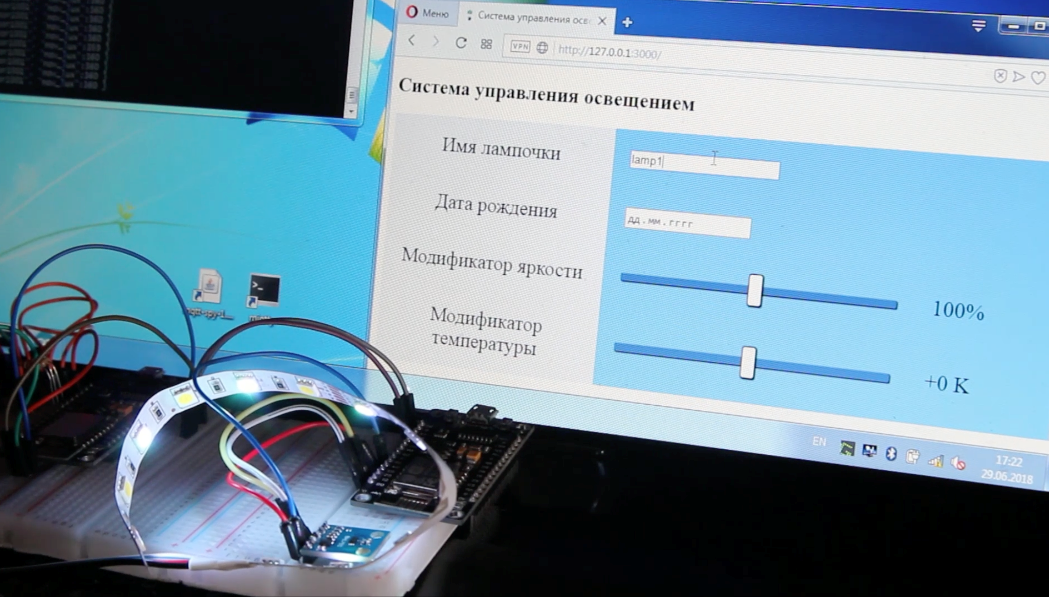
And if you look at the problem wider? After all, it is possible to rebuild the artificial illumination around us so that it imitates the natural course of the sun. The task is especially relevant for those regions of our country where the “white nights” are stunningly beautiful, but it's not at all easy to fall asleep. And not only! The spectrum of lighting can affect not only the sleep mode, but also the level of performance.

In the project of Polina, it is proposed to make a “relaxation room” in the office, in which a person can retire and turn on the lighting, optimal from the point of view of his biorhythms. And in the workplace of an employee during the day, change the color temperature dynamically so as not to disturb our natural biorhythms. Yes, and taking into account the individual characteristics: larks, owls ...
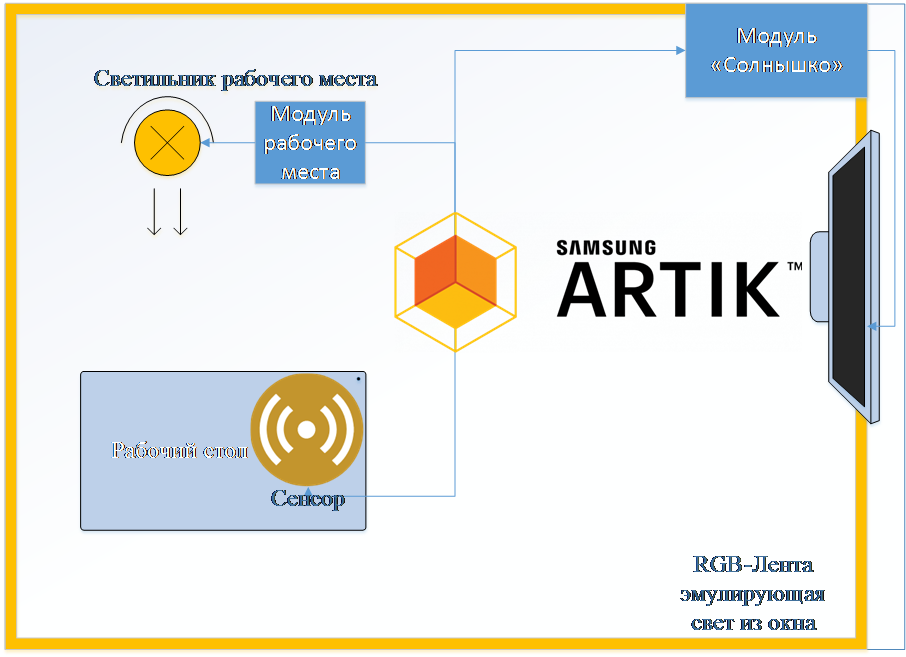
In general, this project is from the category of those stories, when the inability to present their work can lead to failure. At the qualifying stage of the competition it was difficult to guess from the presented materials that automatic lighting control was implemented. The video was a form with "sliders", and it seemed that this was just a trivial "smart light bulb." And only additional comments from the project manager allowed us to estimate the amount of work.
Later in the final round, trainings on presentation skills were organized. The guys demonstrated these absolutely necessary skills in their performance and we believe they will use them in the future.
This project won the audience vote. We have known the author for a long time: exactly a year ago he participated in the first event of the IoT Academy - the Summer School on the Internet of Things, which was held at MIPT.
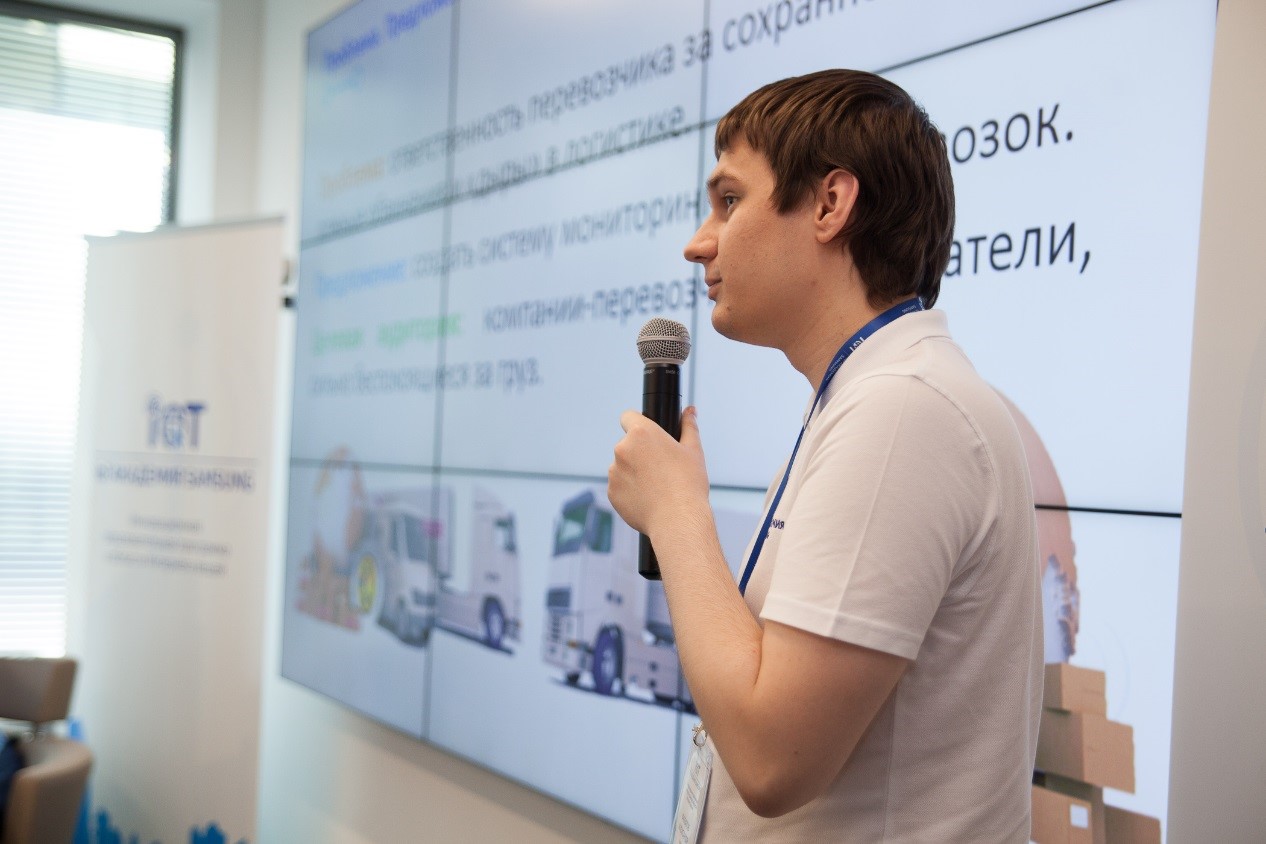
Now Alexander has presented his system for “smart logistics”, which will allow to solve the tasks of tracking and monitoring the conditions of cargo transportation, collecting data on violations. This system can be useful both for insurance companies and for carriers. The project implementation is simple: remote collection of sensor indicators from a tracker attached to a specific load, analysis of these indicators on the server and issuing them to the client in a convenient form. IoT-device is proposed to equip the following sensors: accelerometer, humidity sensors, vibration, tilt, temperature, as well as a GPS-module.
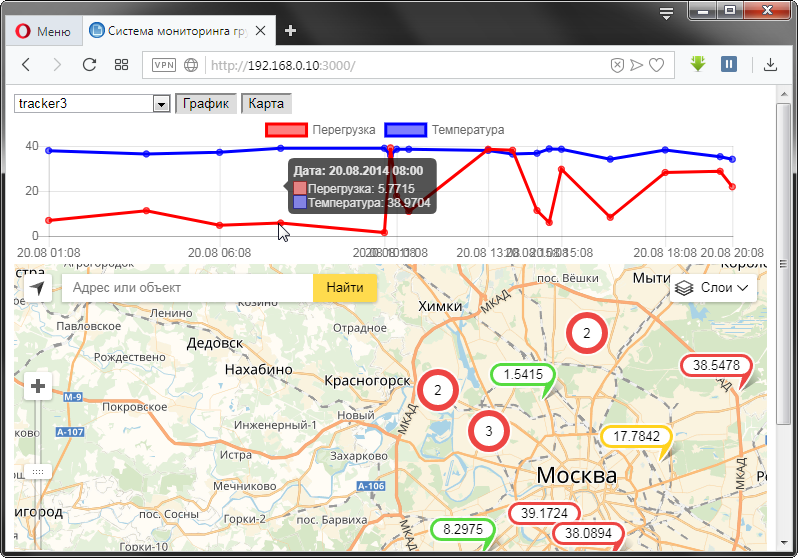
From the merits of the project, we can note the user interface, the appropriate use of the Yandex-Maps API, a mobile application, a competent calculation of energy consumption and the cost of system components.
The project sparked a discussion on several important issues: how to guarantee wireless data transfer if the device is placed with the load inside a metal container? One of the suggestions made by the jury was to develop a structure that does not fit inside, but outside the container. Legal aspects were also discussed: can the testimony of such a device be used in court, in the event of a dispute about liability for damage to the cargo?
I must admit that my sympathies were on the side of this project and I am very glad that the audience gave their votes precisely for him.
The project is from the students of the department of industrial automation of the Institute of Information Technologies MIREA. The problem that the students solved is very simple: there are several villages located far from the district center, with a non-permanent cellular signal. To provide them with water supply installed water towers. Water is pumped into them using pressure stations. To control pressure stations, industrial logic controllers (PLC) are used. To control their work, an operator is required.
In the project, a remote pump control was implemented via a wireless connection to the PLC. The main difficulty of this type of project is to deal with third-party equipment and interfaces. To do this, it took a serious low-level programming to manage the hardware.
The guys at the competition presented a whole demonstration stand consisting of:
Anyone could make sure that the system regularly pumps water from the container to the bottle.
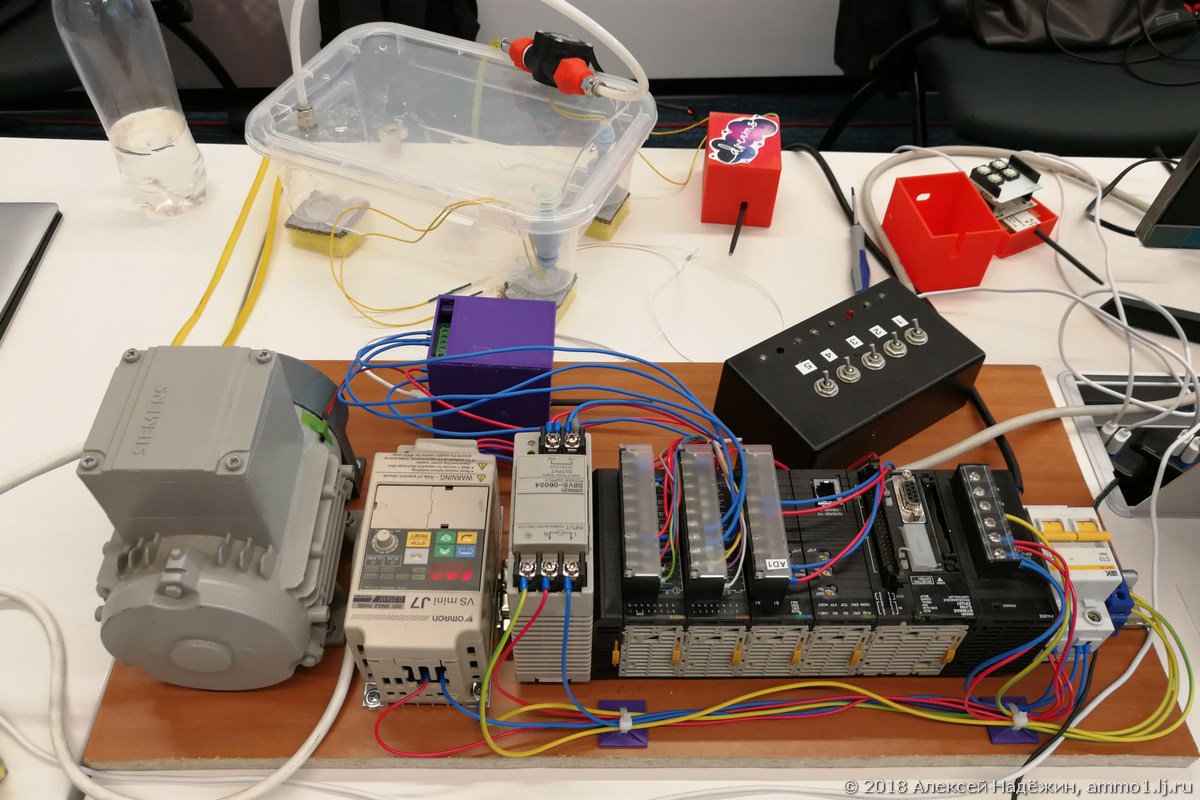
This team has shown inclinations to industrial design, having made nice multi-colored cases on a 3D-printer. They placed the end devices of the “Internet of Things” from the training kit - microcontroller modules with buttons (for manual control of the pump), transistors (for switching the load).
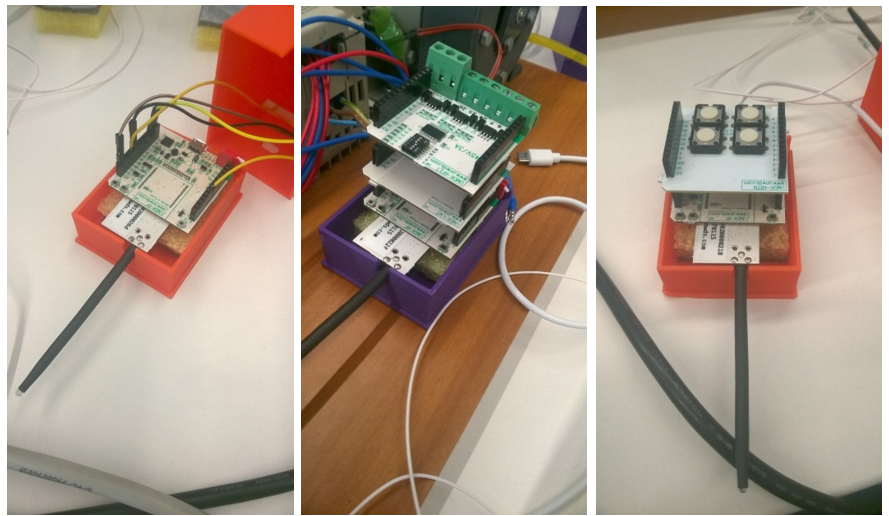
Starovoytov Vyacheslav has already proved on the spring hackathon at MIREA that he is a talented interface designer. And this time, his design of the pump control application looked laconic and stylish:
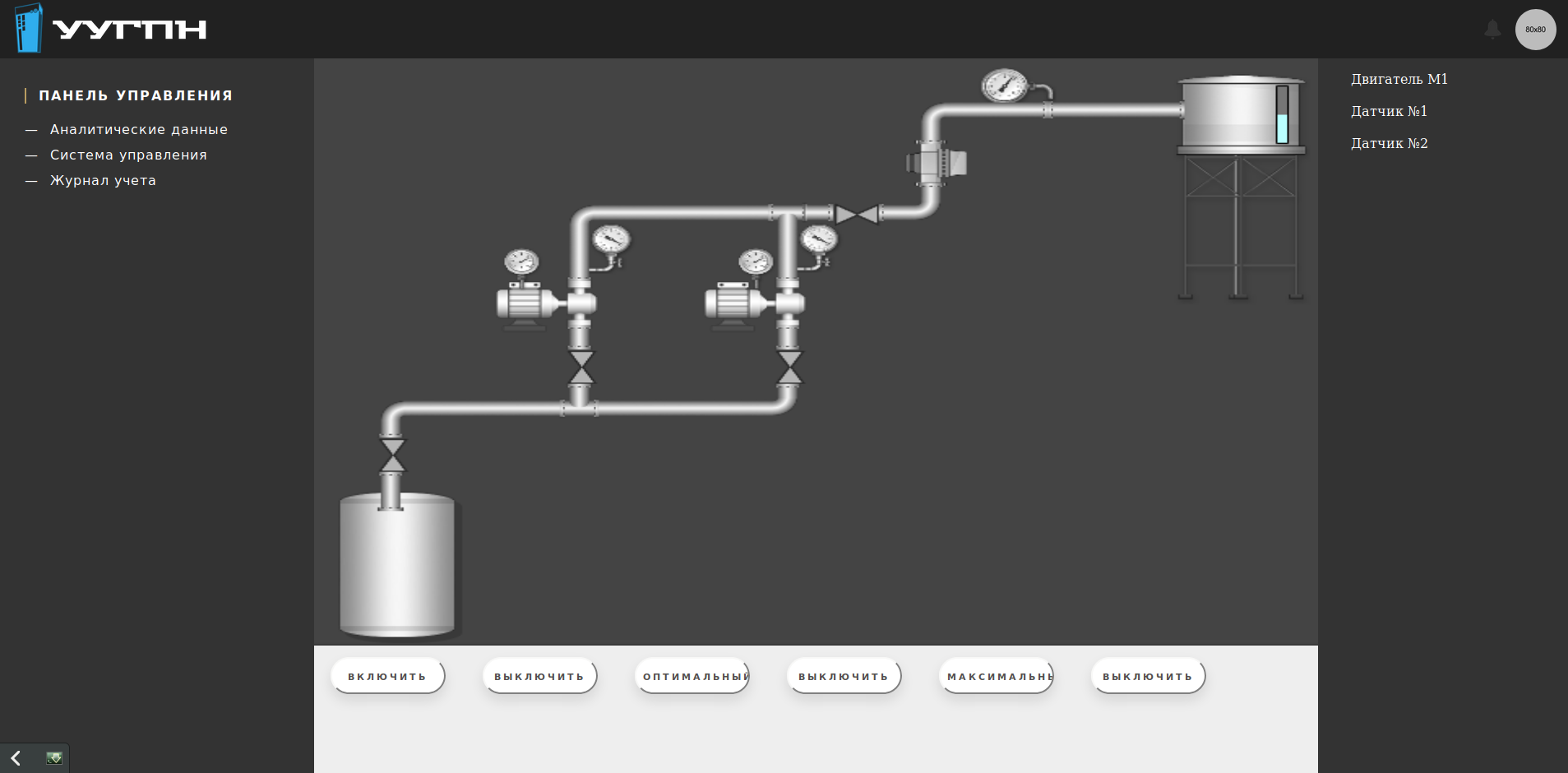
For my article, I chose, from my point of view, the most interesting projects, “a few dozen” student works remained, among which we can mention, for example:
What can be said at the end of the article?
The wide range of approaches and variety of projects makes the field of the Internet of Things extremely interesting. Historically, computer science and engineering were one area of knowledge: the greatest successes were made by people who were equally well versed in mathematics and circuit design, as, for example, my favorite scientist Claude Shannon. Such a synthetic course on the Internet of Things is a way to overcome the limitations of specialization. That is why for me and our teachers this course is especially valuable: here everyone can find the border of their knowledge and try to go for it.
The following fact was noticed: the projects of students of each higher education institution had their own characteristic “face”. This spring, MIPT and MIREA held its additional course on microcontrollers. And it was interesting to observe how Fiztech eventually demonstrated an approach that was closest to the “gland”. The guys moved "from the bottom up", that is, they studied the microcontroller from the point of view of registers, it was difficult and deeply immersed in the material. And at MIREA, the study proceeded “from the top down”, that is, from working in the real-time operating system RIOT on the microcontroller to the dive “down”.
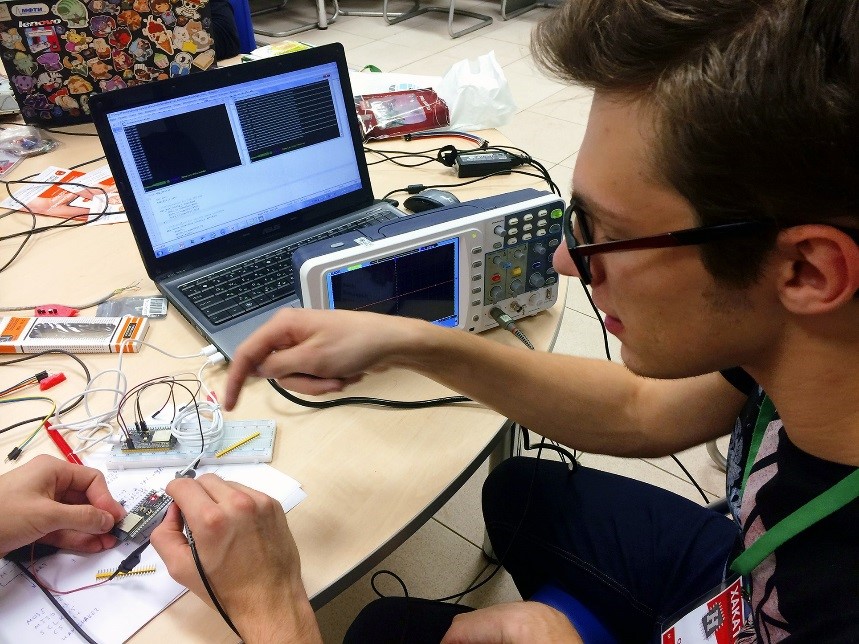
On the hackathon on the Internet of Things at MIPT this spring
As a result, this difference was reflected in most student projects: graduates of our program at MIPT paid most attention to the final device on the microcontroller, achieving maximum efficiency and speed, while MIREA students made higher-level systems, usually with a more user-friendly interface, a mobile application, server part.
Each of the approaches has a right to exist, because it can be useful for working as different specialists and for different purposes, be it rapid prototyping and production. In general, we are satisfied with the technical level of work, the children have mastered the course program. In just one year, they plunged into a completely new subject for themselves and gained the missing knowledge from their profile. At MIREA, several students mastered the material so well and were fascinated by the topics that this year they volunteered to assist the teachers.
And finally, a pleasant result of the survey on the basis of the school year:
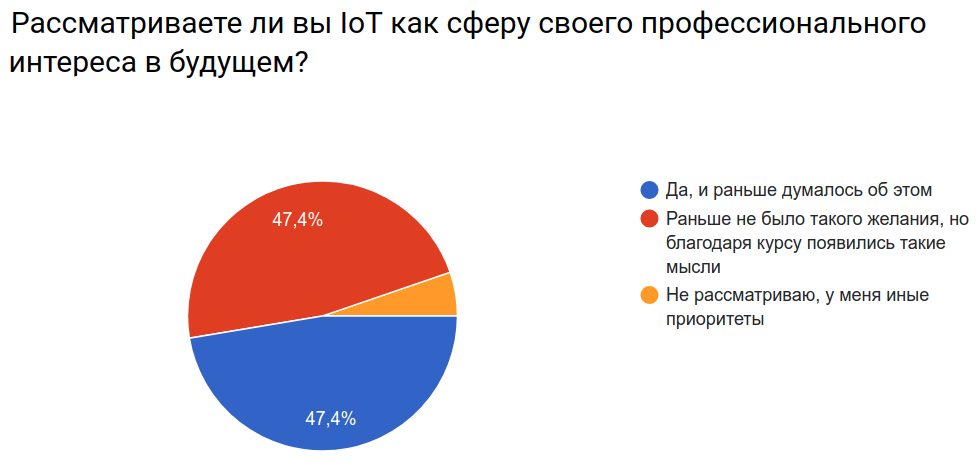
The presented projects were characterized by insufficient elaboration of business aspects. For example, some authors very vaguely imagined who could be the seller of this kind of device, and who the buyer, how the device could be integrated with existing solutions on the market. Many lacked the ability to present the project.
For the sake of justice, it should be noted that these systemic problems are not only characteristic of student-level projects, my colleagues are faced with this in their daily work.
The past finals of the competition allowed us to see the results of the program and how the litmus paper showed those points that are worth working on. We, having rolled up our sleeves, will follow them in the upcoming school year.
With the beginning of the school year, comrades!
 Volkova Tatyana
Volkova Tatyana
Samsung Research Center employee
The author of the curriculum of the project IoT Samsung Academy
The first year of the “IoT Academy Samsung” program ended with a final of the competition held between graduates from pilot universities (MIPT and MIREA). Each of the projects that reached the final was interesting in its own way, and below I suggest to get acquainted with them. This is essentially a demonstration of the range of possible topics that can be covered, based on the knowledge gained in our program.

About the IoT Samsung Academy Program Contest
On July 12, for the first time, an event took place that ended the school year of the IoT Samsung Academy - the final of the inter-university project competition. After the first half of the year devoted to the study of case studies, students of the course at MIREA and MIPT for the entire second semester made their prototypes of the “Internet of things” devices. The students defined the ideas of the projects at their discretion, the teachers were the consultants.
')
For the final, we selected the top 10 projects. The participants had only 5 minutes to speak. A full video of what happened can be viewed on YouTube:
The projects were evaluated by a jury consisting of both professional engineers and representatives of the academic community and business. The jury chairman is Stanislav Polonsky, head of advanced research and development at the Samsung Research Center, a physicist by training, Ph.D., engineer and scientist: he worked in the US for more than 20 years, and his research interests are incredibly broad - from quantum chemistry to medical cybernetics. Your humble servant was the secretary of the jury.

Contest nominations were as follows:
- Technical excellence
- Business and Society
- Absolute winner
- User selection
The winners received such pucks and prizes from our company.

The university-winner of the year, which is determined by the nomination "Absolute winner", was awarded the cup. In addition, the victory was on the side of MIREA in the nominations "Business and Society" and "User Choice." A student from MIPT won the nomination "Technical Excellence".
Project Overview
MotoGuard. Dmitry Faychuk, MIREA
This project by unanimous decision of the jury received the prize "Absolute Winner". The author of the project, Dmitry Faychuk, completed his third year at the Institute of IT MIREA.

In our country, the rights of the junior categories “A1” and “M” are allowed to be issued, starting from 16 years. And many teenagers dream of their moped or scooter. For parents, this is a source of experiences, especially for the safety of the child. Dmitry decided to help in resolving such situations. The task of his device is to track the location and provide the parent with information about dangerous events, such as sudden braking, impact, falling, going beyond the allowed zone. The prototype is a cardboard box, inside which: an STM32 Nucleo L152RE board (this is a card in an Arduino-compatible form factor, but based on an STM32 L1 microcontroller), accelerometer modules, a GPS tracker, a vibration sensor, and a GSM connection.

It is worth noting that the project of Dmitry is quite complex in its architecture: here both the cloud, and the mobile application, and the self-written program for the microcontroller for the RIOT OS operating system.

At the competition, the jury had an obvious question: “Why not use a modern smartphone for solving the problem, because all the necessary sensors (accelerometer, gyroscope, mobile communication) already exist in it?”. However, the author rightly noted that a separate device has several advantages: it can be mounted on a helmet or vehicle, make it non-removable, optimize battery power, make it all-weather, and so on.
Administration of smart safes system. Vladislav Molodtsov, MIPT.
The project was recognized as the best in the nomination "Technical Excellence". The judges were impressed with the degree of technical implementation of the prototype. Particularly struck by the fact that Vladislav was the youngest participant in the final round of the competition.

Yes, Vladislav Molodtsov is a first-year student, but many undergraduates lack such persistence and hard work. He made the most beautiful demonstration prototype. His safe looks completely real, if you don’t know that it is wooden.
We have known before that students of the Physics and Technology Institute are distinguished by a solid approach and are not looking for easy ways! One simple fact: he even assembled his own electromechanical latch on the servomotor for the door, simply because otherwise "it would not be so interesting."

Vladislav was not able to attend in person, so the speech was held by video link.
The safe has an LCD display, a matrix keyboard, an LED display that shows the state of the safe (open / closed), for which the reed switch and magnet were used. There is a speaker to raise the alarm in case of hacking. I connected all the peripherals myself, without using third-party libraries.

The graphical interface to the program is ingenuous, but understandable. It shows the status of each safe: open, closed, locked, hacked.

It is assumed that such a system could be claimed by hotels, sports clubs, and just any companies where employees have personal lockers. The system has not fully worked out security issues, which, obviously, should be the subject of further development of the project.
The system of simulation of weather conditions and time of day in the polar night. Polina Rozhitskaya, MIREA
This project received a prize in the nomination "Business and Society." This nomination is undoubtedly difficult for students and teachers who do not have the necessary experience in business, and even more so in the emerging market of the Internet of Things. The discussion of the jury was stormy, but in the end the opinions of the jury members agreed that the project of Polina has real business potential.
Perhaps you heard this advice: do not use the smartphone before going to bed? The wording is not entirely correct, because we are talking about the dangers of the cold "blue" light of the smartphone screen. It is known that such light reduces the synthesis of melatonin in the human body, which is also called the sleep hormone. That is why, for example, Samsung smartphones have the option of turning on a blue light filter on a schedule.

And if you look at the problem wider? After all, it is possible to rebuild the artificial illumination around us so that it imitates the natural course of the sun. The task is especially relevant for those regions of our country where the “white nights” are stunningly beautiful, but it's not at all easy to fall asleep. And not only! The spectrum of lighting can affect not only the sleep mode, but also the level of performance.

In the project of Polina, it is proposed to make a “relaxation room” in the office, in which a person can retire and turn on the lighting, optimal from the point of view of his biorhythms. And in the workplace of an employee during the day, change the color temperature dynamically so as not to disturb our natural biorhythms. Yes, and taking into account the individual characteristics: larks, owls ...

In general, this project is from the category of those stories, when the inability to present their work can lead to failure. At the qualifying stage of the competition it was difficult to guess from the presented materials that automatic lighting control was implemented. The video was a form with "sliders", and it seemed that this was just a trivial "smart light bulb." And only additional comments from the project manager allowed us to estimate the amount of work.
Later in the final round, trainings on presentation skills were organized. The guys demonstrated these absolutely necessary skills in their performance and we believe they will use them in the future.
Cargo monitoring Alexander Filatov, MIREA
This project won the audience vote. We have known the author for a long time: exactly a year ago he participated in the first event of the IoT Academy - the Summer School on the Internet of Things, which was held at MIPT.

Now Alexander has presented his system for “smart logistics”, which will allow to solve the tasks of tracking and monitoring the conditions of cargo transportation, collecting data on violations. This system can be useful both for insurance companies and for carriers. The project implementation is simple: remote collection of sensor indicators from a tracker attached to a specific load, analysis of these indicators on the server and issuing them to the client in a convenient form. IoT-device is proposed to equip the following sensors: accelerometer, humidity sensors, vibration, tilt, temperature, as well as a GPS-module.

From the merits of the project, we can note the user interface, the appropriate use of the Yandex-Maps API, a mobile application, a competent calculation of energy consumption and the cost of system components.
The project sparked a discussion on several important issues: how to guarantee wireless data transfer if the device is placed with the load inside a metal container? One of the suggestions made by the jury was to develop a structure that does not fit inside, but outside the container. Legal aspects were also discussed: can the testimony of such a device be used in court, in the event of a dispute about liability for damage to the cargo?
I must admit that my sympathies were on the side of this project and I am very glad that the audience gave their votes precisely for him.
Remote control and monitoring of a group of industrial pumps. Vyacheslav Starovoytov and Kirill Komarov, MIREA
The project is from the students of the department of industrial automation of the Institute of Information Technologies MIREA. The problem that the students solved is very simple: there are several villages located far from the district center, with a non-permanent cellular signal. To provide them with water supply installed water towers. Water is pumped into them using pressure stations. To control pressure stations, industrial logic controllers (PLC) are used. To control their work, an operator is required.
In the project, a remote pump control was implemented via a wireless connection to the PLC. The main difficulty of this type of project is to deal with third-party equipment and interfaces. To do this, it took a serious low-level programming to manage the hardware.
The guys at the competition presented a whole demonstration stand consisting of:
- Programmable logic controller (PLC) Omron CJ1M
- Frequency converter Omron VS mini J7
- Siemens 1LA7050-2AA60 engine
- Unwired Devices microcontroller modules for remote control of pumps, connecting to a base station via LoRa
Anyone could make sure that the system regularly pumps water from the container to the bottle.

This team has shown inclinations to industrial design, having made nice multi-colored cases on a 3D-printer. They placed the end devices of the “Internet of Things” from the training kit - microcontroller modules with buttons (for manual control of the pump), transistors (for switching the load).

Starovoytov Vyacheslav has already proved on the spring hackathon at MIREA that he is a talented interface designer. And this time, his design of the pump control application looked laconic and stylish:

Other projects
For my article, I chose, from my point of view, the most interesting projects, “a few dozen” student works remained, among which we can mention, for example:
- Smart bath. The project was distinguished by an original idea and caused genuine interest and excitement not only among the jury, but also among the guests of the competition. Probably because the “bath” is a topic that everyone understands. The essence of the project was to signal that the permissible thresholds in the room were exceeded, and to monitor the condition of the bath visitor: is he moving, or is he already unconscious?
- Employee location indicator for the head of department, made as a program for smart watches Samsung Gear S3. Strong educational project with a large amount of independent study of web programming in JavaScript.
- The system of adaptive ventilation is a practical task, coming from real life, and an interesting working prototype - but the solution, unfortunately, is not worked out from the point of view of the system as a whole, and is very energy-intensive.
- “Smart Store” - building a light path from shelf to shelf, based on the current workload of departments and the marketing policy of the store.
- The system of monitoring the load on the block simulators: add sensors to the moving parts of the simulators and count how many times a person does the exercise.
- A mathematical model for predicting the failure of a vibration sensor on a milling machine is a very well-known task in the IoT world, which is often solved using machine learning methods. We in Russia have practically no publications on this topic, but abroad you will immediately find about 20 articles.
- Construction of a map of the reservoir based on data from ultrasound sensors placed on small moving vessels. We rejected this project due to the fact that the guys focused on solving the problem within the framework of the computer model, and we still preferred real devices.
Conclusion
What can be said at the end of the article?
The wide range of approaches and variety of projects makes the field of the Internet of Things extremely interesting. Historically, computer science and engineering were one area of knowledge: the greatest successes were made by people who were equally well versed in mathematics and circuit design, as, for example, my favorite scientist Claude Shannon. Such a synthetic course on the Internet of Things is a way to overcome the limitations of specialization. That is why for me and our teachers this course is especially valuable: here everyone can find the border of their knowledge and try to go for it.
The following fact was noticed: the projects of students of each higher education institution had their own characteristic “face”. This spring, MIPT and MIREA held its additional course on microcontrollers. And it was interesting to observe how Fiztech eventually demonstrated an approach that was closest to the “gland”. The guys moved "from the bottom up", that is, they studied the microcontroller from the point of view of registers, it was difficult and deeply immersed in the material. And at MIREA, the study proceeded “from the top down”, that is, from working in the real-time operating system RIOT on the microcontroller to the dive “down”.

On the hackathon on the Internet of Things at MIPT this spring
As a result, this difference was reflected in most student projects: graduates of our program at MIPT paid most attention to the final device on the microcontroller, achieving maximum efficiency and speed, while MIREA students made higher-level systems, usually with a more user-friendly interface, a mobile application, server part.
Each of the approaches has a right to exist, because it can be useful for working as different specialists and for different purposes, be it rapid prototyping and production. In general, we are satisfied with the technical level of work, the children have mastered the course program. In just one year, they plunged into a completely new subject for themselves and gained the missing knowledge from their profile. At MIREA, several students mastered the material so well and were fascinated by the topics that this year they volunteered to assist the teachers.
And finally, a pleasant result of the survey on the basis of the school year:

The presented projects were characterized by insufficient elaboration of business aspects. For example, some authors very vaguely imagined who could be the seller of this kind of device, and who the buyer, how the device could be integrated with existing solutions on the market. Many lacked the ability to present the project.
For the sake of justice, it should be noted that these systemic problems are not only characteristic of student-level projects, my colleagues are faced with this in their daily work.
The past finals of the competition allowed us to see the results of the program and how the litmus paper showed those points that are worth working on. We, having rolled up our sleeves, will follow them in the upcoming school year.
With the beginning of the school year, comrades!
 Volkova Tatyana
Volkova TatyanaSamsung Research Center employee
The author of the curriculum of the project IoT Samsung Academy
Source: https://habr.com/ru/post/422641/
All Articles